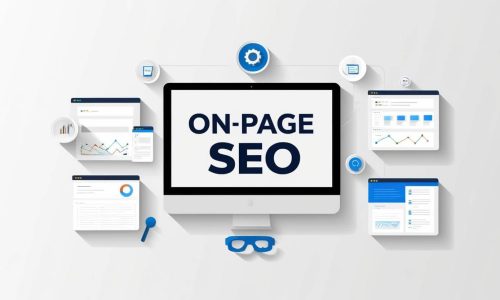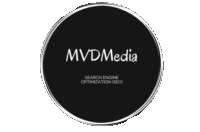On-Page SEO: The Complete Guide for Beginners (With Checklist)

SEO can be overwhelming; understanding the fundamentals of on-page optimization is essential. On-page SEO refers to all the measures you can take directly within your website to improve its search engine rankings. From optimizing content and images to ensuring your site is easy to navigate, on-page SEO is the foundation of any successful SEO strategy.
In this blog post, we’ll break down everything you need to know about on-page SEO, including basic information about on-page SEO, how to start with on-page SEO on your own, the best free tools, and a handy checklist to help you optimize your website like a pro. Whether you’re a complete beginner or looking to brush up on your skills, this guide will give you the tools you need to succeed.
REQUEST YOUR FREE ON-PAGE SEO AUDIT
Is your website struggling to rank on Google? Don’t guess what’s wrong, find out exactly what’s holding you back. My free on-page SEO audit gives you a complete breakdown of your website’s strengths, weaknesses, and actionable improvements you can implement immediately.
What Is On-Page SEO?
On-page SEO refers to all the actions you take directly on your website to help it rank better in search engines, such as title optimization, meta tag optimization, using the right density of keywords, …
It’s all about optimizing elements on your pages to make them more attractive to search engines like Google. It’s about making sure search engines understand what your page is about. This includes things like using the right keywords in your titles, headers, and throughout your content so Google can easily index your pages and show them to the right audience.
Apart from on-page SEO, there’s also off-page SEO and technical SEO — the three main pillars of a strong SEO strategy.
Why Is On-Page SEO Still Important in 2025?
On-page SEO is the backbone of your entire SEO strategy. If you want your website to rank well on search engines like Google, optimizing your pages is the first step in making sure you’re noticed.
Even though SEO may seem like a constantly shifting landscape. On-page SEO is a solid foundation that will always play a crucial role. By focusing on your website’s structure, content, and technical aspects, you’re ensuring your site is easy to crawl, engaging for users and perfectly optimized for ranking.
In 2025, on-page SEO remains incredibly important because search engines are getting smarter. Google’s algorithms now prioritize quality user experience, mobile-friendliness, and fast loading times. All things you can optimize directly on your website. With Google’s continuous updates and the rise of features like rich snippets, on-page SEO helps ensure that your website stands out in the search results.
How To Start On-Page SEO?
You don’t need to be a tech genius or SEO guru to start. With a few simple steps, you’ll already be ahead of most websites out there.
1. Start With the Right Keyword (But Keep It Natural)
Find the right keyword starts with solid keyword research. So before you start writing, ask yourself: “what would someone search to find this page?” The answer to that question should be your target keyword. This keyword should guide your content, but make sure it’s natural.
A little tip: if you find a target keyword, check the competition and search volume on Google Keyword Planner. The winning keywords have a low competition and a high search volume.
Place your main keyword naturally in:
- The page title (that’s the headline in search results)
- Your URL (keep it short and sweet)
- The first paragraph
- One or two subheadings
- A few spots throughout your content
Apart from using your main keyword, make use of LSI keywords. These are related words to your main keyword.
2. Write High-Quality Content That Answers Real Questions
Google loves high-quality content that answers questions clearly. Focus on solving a real problem for your reader, not just impressing search bots.
You don’t have to write a novel. Just cover the topic completely and structure it so your readers can skim and still learn something.
Here are a few tips:
- Use short paragraphs, bullet points, and headings to break things up.
- Answer common questions (hint: check “People Also Ask” on Google).
- Give examples, use real words (skip the jargon), and write like you talk.
Your page should be that one page that finally helps people on that one subject.
3. Optimize Your Page Elements (These Are Easy Wins)
Title Tag
Also known as ‘meta title‘ is the title people see in search results. Keep it under 60 characters and include your keyword near the front.
Meta Description
Think of your meta description as your page’s mini-ad in search results. Make it catchy, include your keyword, and keep it under 160 characters.
Headings (H1, H2, H3…)
Use headings to organize your content, like chapters in a book. Use just one H1 (your main title) and break up the rest with H2s and H3s.
Image Alt Text
Add descriptive alt text to your images so search engines and visually impaired users know what’s in them.
Learn the key differences between alt text and image description.
Internal Links
Link to other relevant blog posts or pages on your site. This helps users explore and tells Google how your pages connect.
URL Structure
Keep URLs short, readable, and keyword-rich. For example: yourdomain.com/on-page-seo-guide instead of yourdomain.com/blog-post-47?id=9832
4. Strengthen Your Google E-E-A-T Signals
Google E-E-A-T stands for experience, expertise, authoritativeness and trustworthiness. It’s how Google evaluates whether your content is high-quality and reliable. Focusing on E-E-A-T helps your pages earn more trust, rank higher, and provide real value to readers.
Here is how you do it:
- Experience: Show that you’ve personally used, tested, or applied the topic. Real-world examples and case studies make your content authentic.
- Expertise: Prove you know your subject deeply. Well-researched advice, clear explanations, and actionable tips demonstrate knowledge that readers and Google can trust.
- Authoritativeness: Build recognition from reputable sources. Backlinks, mentions, and collaborations signal that others respect your work.
- Trustworthiness: Be transparent and accurate. Clear sourcing, secure websites, and honest policies reassure both users and search engines.
Optimizing for Google E-E-A-T is like giving your website a credibility boost that lasts.
5. Focus on User Experience
On-page SEO isn’t only for Google. It’s also for your audience! Google will reward sites that give their users an excellent experience.
Make sure your site:
- Loads fast (under 3 seconds is ideal)
- Looks great on mobile devices
- Has easy-to-read text with good contrast
- Doesn’t hit people with 9 pop-ups before they see your content
Search engines notice when people leave your page quickly. The longer your visitors stay, the better your website will rank.
6. Build Smart Internal Links
Internal linking is one of the most underrated on-page SEO strategies. It’s super simple to do.
Whenever you mention something you’ve written about elsewhere, link to it. This helps with:
- Keeping visitors longer on your site
- Guiding people to other useful resources
- Showing search engines how your content is connected
Here is how to do it:
- Use natural anchor text (don’t over-optimize with exact keywords)
- Link only when it makes sense contextually
- Avoid stuffing links: aim for quality, not quantity
- Update old posts to link to new ones when relevant
It’s like creating a helpful web of content that keeps your audience engaged and search engines happy.
Advanced On-Page SEO Tactics
It’s time to dive deeper and explore a few advanced on-page SEO tactics that can help you stay ahead of the competition and signal real authority to Google.
1. Use Semantic SEO
Google doesn’t just look for exact-match keywords anymore. It looks for meaning, and that’s where semantic SEO comes in.
By covering related topics and using relevant phrases, you help search engines fully understand your content.
Let’s say your page is about “on-page SEO.” Don’t stop at that. Also mention:
- Keyword placement
- Meta tags
- User experience
- Page speed
- Mobile optimization
- Internal links
These terms show you understand the topic deeply and help your page rank for more searches, not just one.
2. Add Schema Markup
Schema markup is like giving Google a highlighter. It tells search engines exactly what’s on your page and can help you win rich results.
Here are a few types of schema you can use on your blog posts:
- Article schema: helps with blog content
- FAQ schema: great for Q&A sections
- How-To schema: perfect for step-by-step guides
- Breadcrumb schema: shows structure in search results
You can use free tools like Google’s Structured Data Markup Helper or plugins like Rank Math or Yoast (for WordPress users) to add schema without code.
3. Refresh and Repurpose Old Content
Instead of always writing something new, it can be good to update your old content:
- Add new insights, tools, or screenshots
- Improve readability and structure
- Fix broken links
- Optimize the meta title and description
Google loves fresh content. By updating your old blog posts, you give them a second life and increase your chances of ranking again.
4. Optimize for Featured Snippets
A featured snippet is that little answer box you sometimes see at the top of Google search results. Win this and your website will have a massive boost in organic traffic.
Here’s how:
- Find a question people ask
- Answer it clearly in 40–60 words
- Use a paragraph, list, or table, depending on the type of answer
- Place your answer high up in your post, ideally after a subheading
You’re not guaranteed to get the snippet, but structured, focused answers increase your chances massively.
5. Improve Content Depth With Supporting Media
Text-only pages are fine. But Google notices when your content includes useful extras, like images, charts, videos, or diagrams.
This boosts time on page and shows you’re providing a richer experience. It also helps users understand your content faster.
Tips for doing it right:
- Add screenshots to walkthroughs
- Use comparison tables for tools or strategies
- Embed videos (your own or from trusted sources)
- Add image alt text and compress your files for speed
Don’t just decorate your page. Add media that helps your audience understand your message.
6. Use Content Hubs
Advanced on-page SEO isn’t just about individual pages. It’s about how your content connects.
A great strategy is building content hubs: pillar pages supported by cluster posts on subtopics.
Here’s how it works:
- Your pillar page targets a broad topic (e.g., “on-page SEO”)
- You write related blog posts (e.g., “best tools for on-page SEO”, “meta tags explained”, “how to use schema”)
- You link between them: from pillar to post and post back to pillar
This builds topic authority, improves internal navigation, and helps Google understand your site structure.
The Best Free On-Page SEO Tools
Now that you have learned the basics of on-page SEO, it’s time to give you some of my favorite free tools to help you with all of the above.
These free on-page SEO tools will help you optimize your on-page SEO and give Google everything it wants.
1. Rank Math (For On-Page Optimization in WordPress)
If you’re using WordPress, Rank Math is like having an SEO assistant right in your dashboard. This free plugin gives you real-time feedback as you write and tells you exactly what to improve.
Rank Math will give you tips on:
- Using your focus keyword in the right spots
- Optimizing images with alt text
- Improving readability and internal linking
- Adding schema markup with just a few clicks
It’s beginner-friendly and doesn’t get in your way. You can check an SEO score for every post, and it updates as you make changes. It’s like playing a game where the goal is to hit green lights.
2. Surfer SEO (Free Content Editor & Chrome Extension)
Surfer SEO is known for its premium features, but they also offer free tools that can seriously boost your content.
Start with the Surfer SEO Chrome extension. It shows you how competitive a keyword is and suggests word counts and keyword usage.
The free content editor even gives you personalized optimization suggestions based on pages already ranking in Google. It’s a great way to fine-tune your content structure and make sure you’re not missing out on quick SEO wins.
3. Google Search Console
If you haven’t set up Google Search Console yet, do it today! It’s completely free and gives you direct insights from Google itself.
Use it to:
- See which keywords are driving traffic to each page
- Check if your pages are indexed
- Monitor mobile usability and Core Web Vitals
- Spot crawl errors and fix them before they hurt your rankings
You’ll find on-page issues you didn’t even know existed!
4. Ahrefs Broken Link Checker (Fix SEO-Killing Errors Fast)
Broken links hurt user experience and can signal to Google that your site isn’t well maintained. Ahrefs’ free Broken Link Checker makes it super easy to find and fix them. Just plug in your domain, and you’ll get a list of:
- Broken outbound links (you linking to dead pages)
- Broken inbound links (others linking to pages that no longer exist)
Fixing these links is quick, and it shows Google that your site is active and trustworthy. Even though Ahrefs is mostly a premium tool, this free checker is gold.
5. Google Keyword Planner
While it’s technically part of Google Ads, Google Keyword Planner is still one of the best free keyword research tools out there.
Use it to:
- Discover new keywords based on your topic
- Compare keyword volume and competition levels
- Find long-tail keywords with less competition
Look for keywords with low competition and medium-to-high search volume. These are often hidden gems perfect for blog posts or support content around your pillar pages.
You Don’t Need Expensive Tools To Do On-Page SEO
The truth is, the best on-page SEO tool is your brain (and a bit of strategy). But these tools can definitely give you a leg up, especially when you’re learning the ropes or working solo.
Pick one or two to start with, test them out, and build from there. The goal isn’t to use every tool; it’s to find the ones that help you work smarter.
On-Page SEO Checklist
This on-page SEO checklist will be your SEO seatbelt and will be your final step before hitting “publish”.
Whether you’re writing your first blog post or updating an old one, this checklist ensures your page is fully optimized without going overboard. You won’t need 27 browser tabs open, just work through this section and tick the boxes.
1. Before You Write
- Found a focus keyword that’s relevant and has low competition and decent search volume.
- Checked LSI keywords and related terms to naturally include in your content.
- Looked at “People Also Ask” and top-ranking pages to understand what searchers want.
2. Content & Structure
- Used your focus keyword in the first 100 words.
- Written for humans first, not just search engines.
- Answered the reader’s core question clearly and completely.
- Used headings (H2s, H3s) to break up your content.
- Included a featured snippet answer in 40–60 words (when it makes sense).
- Added internal links to at least 2–3 related pages/posts.
- Avoided keyword stuffing (read it aloud—does it sound natural?).
3. Media & Visuals
- Added at least one image (bonus points for original ones or screenshots).
- Written descriptive alt text for every image.
- Embedded useful media (video, table, diagram, chart) where helpful.
- Compressed your images to speed up page load time.
4. On-Page Elements
- Title tag includes your main keyword (preferably near the front).
- Title is under 60 characters and compelling enough to earn the click.
- Meta description is under 160 characters, includes your keyword and sounds human.
- URL is short, readable and contains the keyword (e.g., /on-page-seo-guide).
- Used only one H1 tag for the main title.
- Page is mobile-friendly and looks good on all screen sizes.
- Page loads in under 3 seconds (check with PageSpeed Insights or GTmetrix).
- No annoying pop-ups or aggressive ads that ruin the user experience.
5. Advanced Boosters (Optional but Powerful)
- Schema markup added (Article, FAQ, Breadcrumbs, etc.).
- Content is part of a content hub or pillar page strategy.
- Older content refreshed with new data, images, or updated links.
- Optimized for featured snippets using clear formatting and direct answers.
- Broken internal and outbound links fixed (use a broken link checker).
DOWNLOAD YOUR FREE SEO GUIDE + TEMPLATE
Struggling to get your website noticed on Google? Download my free, beginner-friendly SEO guide + checklist template. In just 6 simple steps you’ll learn how to choose the right keywords, optimize your site with on-page optimization and track results.


